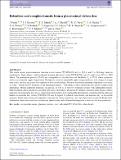Files in this item
Relentless and complex transits from a planetesimal debris disc
Item metadata
| dc.contributor.author | Farihi, J | |
| dc.contributor.author | Hermes, J J | |
| dc.contributor.author | Marsh, T R | |
| dc.contributor.author | Mustill, A J | |
| dc.contributor.author | Wyatt, M C | |
| dc.contributor.author | Guidry, J A | |
| dc.contributor.author | Wilson, T G | |
| dc.contributor.author | Redfield, S | |
| dc.contributor.author | Izquierdo, P | |
| dc.contributor.author | Toloza, O | |
| dc.contributor.author | Gänsicke, B T | |
| dc.contributor.author | Aungwerojwit, A | |
| dc.contributor.author | Kaewmanee, C | |
| dc.contributor.author | Dhillon, V S | |
| dc.contributor.author | Swan, A | |
| dc.date.accessioned | 2022-02-23T12:30:12Z | |
| dc.date.available | 2022-02-23T12:30:12Z | |
| dc.date.issued | 2022-04 | |
| dc.identifier | 277967687 | |
| dc.identifier | 2102b484-0caf-4875-b346-4ba97688f084 | |
| dc.identifier | 85125032047 | |
| dc.identifier | 000754319100001 | |
| dc.identifier.citation | Farihi , J , Hermes , J J , Marsh , T R , Mustill , A J , Wyatt , M C , Guidry , J A , Wilson , T G , Redfield , S , Izquierdo , P , Toloza , O , Gänsicke , B T , Aungwerojwit , A , Kaewmanee , C , Dhillon , V S & Swan , A 2022 , ' Relentless and complex transits from a planetesimal debris disc ' , Monthly Notices of the Royal Astronomical Society , vol. 511 , no. 2 , pp. 1647-1666 . https://doi.org/10.1093/mnras/stab3475 | en |
| dc.identifier.issn | 0035-8711 | |
| dc.identifier.other | Jisc: 101704 | |
| dc.identifier.other | ORCID: /0000-0001-8749-1962/work/108919771 | |
| dc.identifier.uri | https://hdl.handle.net/10023/24937 | |
| dc.description | Funding: T. G. Wilson acknowledges support from STFC consolidated grant number ST/M001296/1. | en |
| dc.description.abstract | This article reports quasi-continuous transiting events towards WD 1054–226 at d = 36.2 pc and V = 16.0 mag, based on simultaneous, high-cadence, multiwavelength imaging photometry using ULTRACAM over 18 nights from 2019 to 2020 March. The predominant period is 25.02 h and corresponds to a circular orbit with blackbody Teq = 323 K, where a planetary surface can nominally support liquid water. The light curves reveal remarkable night-to-night similarity, with changes on longer time-scales, and lack any transit-free segments of unocculted starlight. The most pronounced dimming components occur every 23.1 min – exactly the 65th harmonic of the fundamental period – with depths of up to several per cent, and no evident colour dependence. Myriad additional harmonics are present, as well as at least two transiting features with independent periods. High-resolution optical spectra are consistent with stable, photospheric absorption by multiple, refractory metal species, with no indication of circumstellar gas. Spitzer observations demonstrate a lack of detectable dust emission, suggesting that the otherwise hidden circumstellar disc orbiting WD 1054–226 may be typical of polluted white dwarfs, and detected only via favourable geometry. Future observations are required to constrain the orbital eccentricity, but even if periastron is near the Roche limit, sublimation cannot drive mass loss in refractory parent bodies, and collisional disintegration is necessary for dust production. | |
| dc.format.extent | 20 | |
| dc.format.extent | 4339004 | |
| dc.language.iso | eng | |
| dc.relation.ispartof | Monthly Notices of the Royal Astronomical Society | en |
| dc.subject | White dwarfs | en |
| dc.subject | Circumstellar matter | en |
| dc.subject | Planetary systems | en |
| dc.subject | Stars: individual (WD 1054–226), | en |
| dc.subject | QB Astronomy | en |
| dc.subject | QC Physics | en |
| dc.subject | 3rd-DAS | en |
| dc.subject.lcc | QB | en |
| dc.subject.lcc | QC | en |
| dc.title | Relentless and complex transits from a planetesimal debris disc | en |
| dc.type | Journal article | en |
| dc.contributor.sponsor | Science & Technology Facilities Council | en |
| dc.contributor.institution | University of St Andrews. School of Physics and Astronomy | en |
| dc.identifier.doi | 10.1093/mnras/stab3475 | |
| dc.description.status | Peer reviewed | en |
| dc.identifier.grantnumber | ST/M001296/1 | en |
This item appears in the following Collection(s)
Items in the St Andrews Research Repository are protected by copyright, with all rights reserved, unless otherwise indicated.

